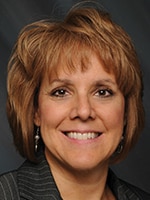September 2023—Point-of-care testing—the requests and the committees that oversee them, the connectivity, what AI might bring. CAP TODAY publisher Bob McGonnagle on July 21 met online with a laboratory operations director and a medical director from large health systems and with company representatives for a look at where things stand today. Their conversation follows.
It’s important that we define what the term point of care is and what it isn’t. We know it’s testing that’s done close to the patient and for which the test result is provided when the patient is still onsite so an intervention, such as adjusting a dosage, can happen. We talk about the tradeoff—convenience versus cost. We know that point-of-care testing and central or core lab testing have to coexist. This is overlaid now with a serious shortage of skilled labor, and, increasingly, patients being directed to patient service centers for their draws. Sarah Province, what more do we need to add to this general concept?
Sarah Province, director, laboratory operations, AdventHealth: I see two aspects to point-of-care testing. One is at the bedside or near the patient and performed with handheld devices for rapid testing and early intervention for usually critical situations. The other is near-patient testing at our freestanding emergency department locations—we refer to them as offsite EDs. We use low-volume laboratory instruments there, similar to in our main laboratory, but the ED lab location is close to the patient for rapid testing.
Kim Skala, can you comment on the definition?

Skala
Kim Skala, MLS(ASCP), associate project manager, customer education programs, Werfen: Having worked in the lab managing point of care for many years and more recently on the manufacturer side, I think it has to be a conversation about what we need to do at the point of care versus what we’re going to do in the main lab. In terms of definition, we’ve seen it become a bit blurred. Point of care might be at an ED tent doing COVID testing or at a freestanding ED, without the support of a traditional main lab setup. Environments are becoming more varied.
Amy Karger, what is the outline of point-of-care testing within the University of Minnesota system?
Amy Karger, MD, PhD, medical director, West Bank Laboratory at M Health Fairview University of Minnesota Medical Center, system director of point-of-care testing for M Health Fairview, and clinical pathologist and associate professor, University of Minnesota Physicians: We have a lot of at-bedside or near-the-patient bedside platforms. In our clinics we have pregnancy tests and glucose meters, et cetera. In our ICUs we have more near-bedside platforms, like blood gas instruments that we can wheel into the unit but are kept in our central lab. We try to be judicious about bringing in new point-of-care tests because there’s a lot to consider when doing that. We have a committee that reviews requests and the pros and cons.
The pandemic expanded our capability to set up pop-up testing sites, as well as clinical and public awareness of at-home testing. We don’t regulate or oversee at-home testing, but as laboratorians we’ll want to keep an eye on it to make sure those tests are high quality.
How many testing personnel do you need to qualify and certify in the course of 12 months at the University of Minnesota?
Dr. Karger (University of Minnesota): I oversee point-of-care testing for our entire health system, which is multiple hospitals and numerous clinics. Hundreds of people are being trained at those sites. When we’re looking at whether to bring in a point-of-care test, one of the considerations is whether it is reasonable to oversee the number of staff who would do that testing and make sure they’re trained properly and compliant with competencies.
Gwenn Brode, none of this can work without IT solutions connecting instruments to the EHR and to the laboratory. Can you comment on your customers’ needs for ever-better connectivity solutions?
Gwenn Brode, product manager, point-of-care testing connectivity solution, Orchard Software: For any kind of point-of-care testing they want to be able to dock the meters and get results to the EHR and to physicians quickly and with minimal user intervention. The same with near-patient testing—they want to get samples to the near-patient instruments and ensure results are efficiently captured and delivered to the patient’s chart in the EHR.
Corinne Fantz, Roche has a breadth of testing solutions that are scalable across the sites of a large health system. Can you talk about the need for families of instruments with compatible operating systems? That is, there’s one process within the box no matter the size of the box.

Dr. Fantz
Corinne Fantz, PhD, chief medical partner, core lab and point of care, and VP, medical and scientific affairs, Roche Diagnostics: It gets to the economies of scale and the patient population you’re serving. If you’re at a large integrated health care network, you would want the patients who are going through that system—who start in the clinic, go to the local community hospital, then to the “mothership” hospital—to have comparable results across that continuum. Having smaller solutions helps standardize that. It’s more difficult to do if you have a variety of systems.
Point-of-care testing in that scenario is a balance between the central lab and the point-of-care and smaller chemistry solutions. What makes sense? It’s the medical problem you’re trying to solve in your patient population. Do all the devices meet the intended use for that population, and do you have the right personnel to perform the testing to accomplish the goal for that population? Sometimes you have that with a smaller device, and sometimes it makes sense, for economies of scale and if you don’t have a turnaround time expectation, to send it to a larger lab.
Sarah, health systems seem to be getting larger, and it would seem that the compatibility of the instruments chosen for their many sites would be a prime consideration. You don’t want multiple manufacturers of a chemistry machine, for example. Is that correct?
Sarah Province (AdventHealth): Yes. We’re highly standardized within our integrated delivery network. We’ve chosen one chemistry platform to be in every laboratory setting. But that might not translate to point of care. There’s not a perfect system that fits both scenarios. For example, we have the Siemens Epoc for our POC basic metabolic panel, which also has hemoglobin. That’s at the bedside. It has its own validated reference ranges that are good and we’ve done strict correlations. When a sample does come to the laboratory for testing, the reference ranges are different but comparable. So they serve their purpose in whatever setting they’re in and work well together. Our physicians do well moving from point-of-care results to the laboratory results.
Amy, there’s point-of-care testing in infectious disease and hematology, and then there are basic chemistries, immunoassays, and others. Does the application or the entity you’re testing for influence how you deploy point of care versus core lab automation?

Dr. Karger
Dr. Karger (University of Minnesota): The area of the type of test, whether it’s hematology, chemistry, or infectious disease, does not matter as much as whether there’s clinical benefit to putting it in place. Are we going to get a good result? Once we do implement, we follow up—do we see the benefit? We want to make sure that what we were anticipating is coming to fruition. So we not only vet before we implement but also monitor to make sure the testing is accurate and providing benefit.
Gwenn, do you think a new lab director of a large system should be paying attention to their IT connectivity solution as one of the first things they begin to evaluate and consider for their large network?
Gwenn Brode (Orchard): Yes, because you want the connectivity to do things that will help when you have labor shortages. You want automation and you want results to come across seamlessly and have rules set up so you don’t have a person sitting at a computer approving results. Connectivity for that purpose is perfect because it removes manual processes that are prone to error and time-consuming for personnel.
Corinne, we know of the various testing committees in which people make decisions about whether to keep a test in a core lab or send it to the point of care. Are those committees peas in a pod or do they differ in their thinking and decision-making?
Dr. Fantz (Roche): There are groups that primarily focus on operational needs. They are interested in workflow and process. Other groups focus on clinical accuracy and innovation and want to offer tests that are on the cutting edge—pioneer-type groups. And there are cost-conscious groups that want the cheapest test available and the fastest result. They look at the financial implications of that testing for their system. There are also blends of these groups. Depending on who’s on the committee and who has the loudest voice, each of these groups could make a different decision. They fall into these categories depending on who’s making the request and what the purpose of the request is. How they address it and how it gets built depends on the hat they have on—an operational hat; an academic, clinical-interest hat; or a cost-conscious hat. And where you see these different solutions pop up—that is, what gets accepted—depends on who makes up that committee, the type of system making the decision, and the problem being presented.
Sarah, competing interests might be represented in a point-of-care testing committee. Where are the asks coming from?
Sarah Province (AdventHealth): We have a set instrument profile for different types of testing; for example, the Siemens Epoc, the Nova Stat Strip for glucose, or the Radiometer ABL90 Flex Plus for co-oximetry. I’m seeing more requests to add these devices as our system grows—“We’re building a new tower, now I need five more devices,” or “We’re adding more beds, so we need more units for this service line.” It’s expanding the fleet of devices into areas that are already using it. The unit medical director has to fill out a justification form and then our point-of-care medical director reviews it, and we estimate the expenses. It typically gets approved if it’s already in place in another location and the justification is sound. We have more than 1,900 POC devices in our system and more than 13,000 users. We’re proponents of point-of-care testing and we see value in it, so it’s more about whether we can support it from a laboratory perspective.
For our manufacturer friends, one takeout would be that incumbency is a great virtue in point-of-care testing, if only because it’s easier to add a unit than change the whole system. Would you agree, Sarah?
Sarah Province (AdventHealth): Yes. The training element for so many users is burdensome; it’s challenging any time we have to change out a device.
Amy, do things work fairly well in these committees at your system?
Dr. Karger (University of Minnesota): Yes. We have a standardization committee of coordinators from each of the main hospitals and clinics that meets monthly, and I’m the medical director of that group. The committee is involved in day-to-day oversight and operations and in discussing issues that pop up. We have a smaller group that reviews and approves new requests, so it’s not up to the coordinators at each site to decide. It gets escalated to me and a few of the other lab leaders to review.
We also get a lot of requests when there are new units or new clinics that do what we’re already doing, and those are pretty easy. As an academic center, there are a lot of providers who go to research or professional meetings and hear about something new, then come back and want us to implement it. When we look into it, there’s no literature; there’s only the manufacturer data. Those are the most challenging—when we don’t have independent research or literature on a platform to help in making a decision. In those situations, if we look into it and it seems like a reasonable clinical ask, sometimes we’ll partner with the manufacturer to do our own independent studies. Or we will try to make an arrangement where we can stop using something if it turns out not to work.
Artificial intelligence is everywhere, and the clinical laboratory and point-of-care testing are no exception. Even at last year’s AACC meeting vendors were talking about their AI applications for their test devices. Corinne, what is your view of that?
Dr. Fantz (Roche): We’re in the beginning stages of what will be possible using AI. There’s a bit of an overcall on what AI is in terms of the solutions available today. A lot of it is rule-checking and having more digital solutions versus learning from data sets and pulling information and representing it in a different way. In the future there will be more decision support for clinicians and solutions to help guide decisions in real time and make predictions on what will happen with a patient.
Gwenn, are you seeing that same interest? There’s plenty of hype, but there’s also an underlying reality that’s making itself felt in this area, correct?
Gwenn Brode (Orchard): Yes. Artificial intelligence for point of care will be great. You’ll be able to put algorithms in that will help physicians create a plan for their patients quicker and with good information.
Kim, what have you been seeing with AI?
Kim Skala (Werfen): I agree with what has been said and would broaden the conversation to data in general. The CAP checklists emphasize risk management—what issues do you have to address at your site? You can use something as simple as a sample-handling report from a Gem Premier 5000 or GemWeb Plus 500 and see that a particular nursing unit is having problems with microclots. The point-of-care coordinator can then focus on that and retrain where it’s needed. It’s using actionable data. Manufacturers are making reports easier to use and call. It’s difficult to call reports for point of care from the LIS; that’s where our middleware is helpful. It helps direct you to problems you need to address at your site, and that may differ from hospital to hospital within a wide system.
We see a growing need for more data for patient blood management. Clinicians want more viscoelastic testing and are using ROTEM Sigma at the point of care to make goal-directed therapy decisions more quickly. There’s so much that can be done, and we’re seeing just the tip of the iceberg.
Dr. Fantz (Roche): There are two sides to that. There’s what Kim is saying, using AI for the laboratory to learn about and improve processes and be patient-specific for what is happening on the floor. And there’s another side with the diagnosis and making sure providers have what they need to be able to use all the data that is generated. There are two types of solutions being built from the manufacturer’s standpoint—those that help laboratories be more efficient and those that help clinicians be more efficient and accurate in their assessments.
Gwenn, as a purveyor of IT solutions, and also for those who are bringing the instruments and tests to bear, does a lot of the job of helping users of point-of-care test results understand what the data mean fall to you? You have customers saying, “Solve my problem: I don’t have enough operators or operators who understand. Can you build in rules, build in more autoverification?”

Brode
Gwenn Brode (Orchard): Yes. We want to make sure clients have the tools to be able to automate results, perform operator certification, distribute the quizzes to get operators certified, and implement rules to prevent approval of results if the operator is not certified. Having all this within the connectivity solution makes it easier.
Kim Skala (Werfen): I agree with Gwenn. Hospitals need that support from the connectivity standpoint. It’s important for manufacturers to provide IT specialists who can help implement new instruments. We also provide project management support for implementations via our clinical application managers.
At the analyzer level, it’s important to make sure your analyzer can detect a microclot or interference and notify the operator when it’s present. We’ll all need hemolysis detection in the future. Many staff members don’t necessarily have the laboratory background or the critical-thinking skills to understand what a preanalytical error is, like a trained medical laboratory scientist would, and how it might affect a patient’s result. So it’s building risk mitigation hardware and software solutions into the analyzers as well.
Sarah Province (AdventHealth): We find that hardwiring our point-of-care download bases is the most reliable way to transmit data. They send information wirelessly, but because our wireless network has been unreliable, especially around the imaging department, in the basement, or in underground areas like our emergency department, it became a challenge. Then we found when instruments moved throughout the hospital, they entered different IP zones, and when they changed IP addresses, sometimes they stopped working. We didn’t know about these challenges until more sophisticated connection methods were implemented.
Corinne, I want to return to what Kim said. I have a thesis that the efficiency and automation that IVD manufacturers were building into their systems were to some degree making up for what was already a developing shortage of skilled laboratory personnel. So the challenge is becoming ever greater for the manufacturers to continue to cover for that staffing shortage. Would you agree?
Dr. Fantz (Roche): Yes, although it’s challenging to ever replace a medical technologist because so much knowledge is needed to work with this equipment. We aim to make their jobs easier so they can do more and do more with less error. If they can rely on these systems to do specific checks, then they can manage the outliers or those tougher samples and spend their time dedicated to where we can use their brainpower. We’re trying to make them more efficient and consistently reliable for some of the decisions they’re making in real time and under pressure.
There’s no question in my mind that that’s essential, but filling those gaps is everyone’s concern, for all parties.
Dr. Fantz (Roche): Yes, and that’s why having AI to tell us what’s happening in the system and do remote patient monitoring of some of the samples in the labs is helpful. If we can see the stream of information, without the HIPAA data, to tell us if something’s wrong with the instrument or if it needs maintenance sooner because of the volume, then we can do preemptive service visits, and that helps the laboratory stay up and running.
Sarah, would you like to make a final comment?

Province
Sarah Province (AdventHealth): We are going to institute the Cobas Liat for rapid strep testing in our pediatric emergency department. We were doing the strep screen there and sending the swabs to the laboratory for confirmation. There was a wait for a PCR test result and the physician was asking for rapid results, so we decided—why not get the PCR test in the emergency department? It’s one and done. It was a nice solution and the doctors are thrilled. And it will expand to more than strep.
How to store reagents is another point. Some reagents have very short outdates, or once you take them out of the refrigerator they have shorter room-temperature expirations so you have to redate them as an open date. It gets to be challenging with nursing. Having room-temperature reagents is essential for point-of-care testing.
Kim Skala (Werfen): I agree. It has to be room-temperature storage for reagents, and the onus is on manufacturers to provide that. It has to be low maintenance or no maintenance for instruments.
Going back to our data discussion, it’s about patient-specific data. It’s important to know if there is a residual drug effect for a patient who is on a direct oral anticoagulant and needs a procedure. We need instruments like VerifyNow to provide that information.
With cost a consideration, everyone is looking at plug-and-play management and wanting to make sure they have the right product for the right patient at the right time. We, as manufacturers, have to support our customers as best we can, in all of these ways.
Corinne, do you have final comment?
Dr. Fantz (Roche): People assume point of care is less accurate. That’s not always the case. We saw a lot of success during the pandemic with molecular methods at the point of care. We’re going to start seeing high-sensitivity troponin methods at the point of care. You have to understand the medical need, the problem you’re trying to solve, and then find the right solution with the right connectivity so you can be as efficient as possible. And within your system, look at the whole patient care journey, not just that one point in time, to make these decisions.
 CAP TODAY Pathology/Laboratory Medicine/Laboratory Management
CAP TODAY Pathology/Laboratory Medicine/Laboratory Management
